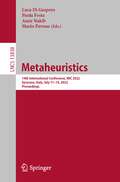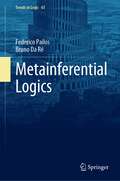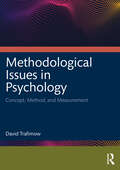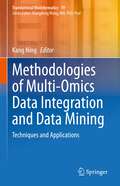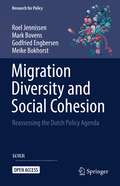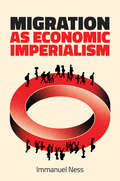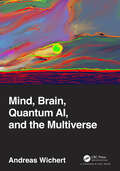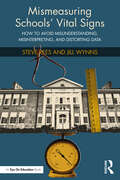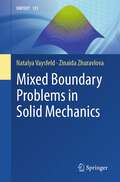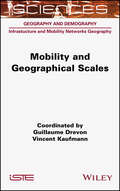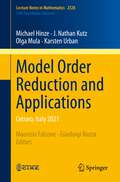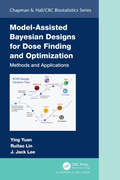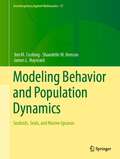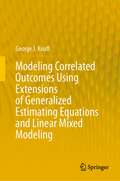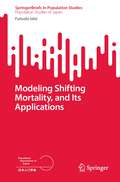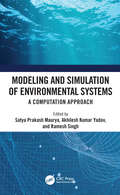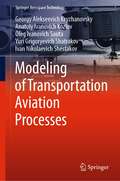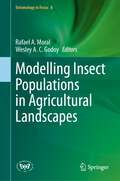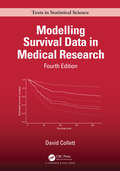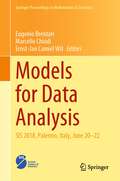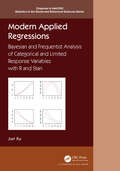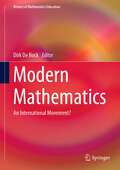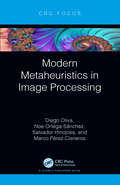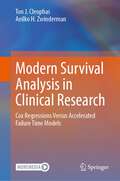- Table View
- List View
Metaheuristics: 14th International Conference, MIC 2022, Syracuse, Italy, July 11–14, 2022, Proceedings (Lecture Notes in Computer Science #13838)
by Luca Di Gaspero Paola Festa Mario Pavone Amir NakibThis book constitutes the refereed proceedings of the 14th International Conference on Metaheuristics, MIC 2022, held in Syracuse, Italy, in July 2022.The 48 full papers together with 17 short papers presented were carefully reviewed and selected from 72 submissions. The papers detail metaheuristic techniques.
Metainferential Logics (Trends in Logic #61)
by Federico Pailos Bruno Da RéThis book is the first to present a comprehensive investigation of the technical features of the metainferential logics developed in the last years, with their most relevant results and applications. It provides some new paths to define and investigate metainferential logics and offers a thorough study of the semantics and the proof-theories of this new and exciting variety of families of logics.This volume examines the hierarchies of metainferential logics and gives a general and systematic theory of them, and of the truth theories based on these logics. This book puts forward the prospects for truth-theories based on the metainferential logics of the TS/ST hierarchy and argues for its promise noting that each of these logics can be safely expanded with a transparent truth predicate. It also goes onto to explore new developments in three fields related to logics – namely metainferential logics built by means of the Weak Kleene schema and combining them with logics defined through the Strong Kleene schema, proof-theoretic presentations, and those with a with a global or an absolutely global validity standard, instead of a local one. This book is of interest to scholars in formal logic.
Methodological Issues in Psychology: Concept, Method, and Measurement
by David TrafimowMethodological Issues in Psychology is a comprehensive text that challenges current practice in the discipline and provides solutions that are more useful in contemporary research, both basic and applied. This book begins by equipping the readers with the underlying foundation pertaining to basic philosophical issues addressing theory verification or falsification, distinguishing different levels of theorizing, or hypothesizing, and the assumptions necessary to negotiate between these levels. It goes on to specifically focus on statistical and inferential hypotheses including chapters on how to dramatically improve statistical and inferential practices and how to address the replication crisis. Advances to be featured include the author's own inventions, the a priori procedure and gain-probability diagrams, and a chapter about mediation analyses, which explains why such analyses are much weaker than typically assumed. The book also provides an introductory chapter on classical measurement theory and expands to new concepts in subsequent chapters. The final measurement chapter addresses the ubiquitous problem of small effect sizes in psychology and provides recommendations that directly contradict typical thinking and teaching in psychology, but with the consequence that researchers can enjoy dramatically improved effect sizes. Methodological Issues in Psychology is an invaluable asset for students and researchers of psychology. It will also be of vital interest to social science researchers and students in areas such as management, marketing, sociology, and experimental philosophy.
Methodologies of Multi-Omics Data Integration and Data Mining: Techniques and Applications (Translational Bioinformatics #19)
by Kang NingThis book features multi-omics big-data integration and data-mining techniques. In the omics age, paramount of multi-omics data from various sources is the new challenge we are facing, but it also provides clues for several biomedical or clinical applications. This book focuses on data integration and data mining methods for multi-omics research, which explains in detail and with supportive examples the “What”, “Why” and “How” of the topic. The contents are organized into eight chapters, out of which one is for the introduction, followed by four chapters dedicated for omics integration techniques focusing on several omics data resources and data-mining methods, and three chapters dedicated for applications of multi-omics analyses with application being demonstrated by several data mining methods. This book is an attempt to bridge the gap between the biomedical multi-omics big data and the data-mining techniques for the best practice of contemporary bioinformatics and the in-depth insights for the biomedical questions. It would be of interests for the researchers and practitioners who want to conduct the multi-omics studies in cancer, inflammation disease, and microbiome researches.
Migration Diversity and Social Cohesion: Reassessing the Dutch Policy Agenda (Research for Policy)
by Godfried Engbersen Mark Bovens Roel Jennissen Meike BokhorstThis open access book shows policymakers which initiatives work when responding to the increasing diversity in cities, towns and neighborhood's. In recent times, policymakers have grappled with ways of responding to this increase, which has resulted in a plethora of policy initiatives, some more effective than others. Bringing together a large amount of research and evidence-based policy recommendations, this book offers both a sense of strategic direction as well as more specific, actionable advice. It brings together a remarkable mixture of policy areas that touch upon issues of diversity, immigration policy, education, and labour policy. It is of benefit and importance to all those making policies for a country with increasing immigration.
Migration as Economic Imperialism: How International Labour Mobility Undermines Economic Development in Poor Countries
by Immanuel NessFor several decades, wealthy states, international development agencies and multinational corporations have encouraged labour migration from the Global South to the Global North. As well as providing essential workers to support the transformation of advanced economies, the remittances that migrants send home have been touted as the most promising means of national development for poor and undeveloped countries. As Immanuel Ness argues in this sharp corrective to conventional wisdom, temporary labour migration represents the most recent form of economic imperialism and global domination. A closer look at the economic and social evidence demonstrates that remittances deepen economic exploitation, unravel societal stability and significantly expand economic inequality between poor and rich societies. The book exposes the damaging political, economic and social effects of migration on origin countries in Africa, Asia and Latin America, and how border and security mechanisms control and marginalize low-wage migrant workers, especially women and youth. Ness asserts that remittances do not bring growth to poor countries but extend national dependence on the export of migrant workers, leading to warped and unequal development on the global periphery. This expert take will be a valuable resource for students and scholars of migration and development across the social sciences.
Mind, Brain, Quantum AI, and the Multiverse
by Andreas WichertMind, Brain, Quantum AI, and the Multiverse There is a long-lasting controversy concerning our mind and consciousness.This book proposes a connection between the mind, the brain, and the multiverse. The author introduces the main philosophical ideas concerning mind and freedom, and explains the basic principles of computer science, artificial intelligence of brain research, quantum physics, and quantum artificial intelligence. He indicates how we can provide an answer to the problem of the mind and consciousness by describing the nature of the physical world. His proposed explanation includes the Everett Many-Worlds theory. Mind, Brain, Quantum AI, and the Multiverse tries to avoid any non-essential metaphysical speculations. The book is an essential compilation of knowledge in philosophy, computer science, biology, and quantum physics. It is written for readers without any requirements in mathematics, physics, or computer science.
Mismeasuring Schools’ Vital Signs: How to Avoid Misunderstanding, Misinterpreting, and Distorting Data
by Steve Rees Jill WynnsThis book helps school and district leaders avoid the pitfalls that await those making sense of their school’s data. Whether you're interpreting achievement gaps, graduation rates or test results, you're at risk of reaching a mistaken judgment. By learning about common errors and how they’re made, you'll be ready to choose safer, surer paths to making better sense of the wealth of data in your school or district. The authors help educators build better evidence, see conclusions more clearly, and explain the data more persuasively. Special features Include: "Questions to Spark Discussion" in each chapter encourage school site, district leaders, and board trustees to apply each chapter’s content to their own situations. Data visualizations, together with the authors’ interpretations, will help you learn how to do visual analysis (and reach the right conclusions). Practical tips provide clear guidance. Supplemental resources can be found at the book’s website, k12measures.com, including interactive data visualizations and analytic exercises to help you learn a concept by "doing."
Mixed Boundary Problems in Solid Mechanics (UNITEXT #155)
by Natalya Vaysfeld Zinaida ZhuravlovaThe book covers a wide range of subjects and techniques related to mixed boundary problems of elasticity from basic concepts to special techniques that are unlikely to appear in traditional university graduate courses. This book may also be of interest to industrial researchers who encounter defects such as cracks and inclusions of different materials in mechanisms under different localization and type of loading. So the topics present the application of mathematical mechanics of solid bodies notably in elasticity, showing the interconnection of elasticity and temperature that would normally treated independently. Theoretical and experimental results are expected to be useful for researchers investigating a wide range of materials including metals, composites, ceramics, polymers, biomaterials and nanomaterials under different mechanical and temperature loading. The aim of the book is to introduce an interdisciplinary audience to a variety of stress state phenomena occurring in elasticity near defects and edges of the bodies. The book is aimed at researchers, primarily but not exclusively graduate students, postdoctoral researchers, specialists from Aerospace and Civil Engineering, Materials Science, and Engineering Mechanics and should naturally also be of interest to specialists of Physics and Applied Mathematics.
Mobility and Geographical Scales
by Vincent Kaufmann Guillaume DrevonThe concept of mobility has grown enormously over the last two decades. A large part of the social sciences has been interested in the different forms of mobility, from a wide variety of spatial and temporal scales. This book presents the different spatial and temporal scales of mobility and the way in which they form a system, by associating them with essential and original research objects. It provides an in-depth review of scientific knowledge, a perspective on major societal issues, analytical tools and a discussion on the main current academic debates. The authors highlight the need to take into account both the spatial and temporal scales of mobility in order to address contemporary environmental and societal issues. The book invites us to think about the entanglement of these different scales from the analysis of rhythms by founding a rhythmology of contemporary mobilities.
Model Order Reduction and Applications: Cetraro, Italy 2021 (Lecture Notes in Mathematics #2328)
by Michael Hinze Karsten Urban J. Nathan Kutz Olga MulaThis book addresses the state of the art of reduced order methods for modelling and computational reduction of complex parametrised systems, governed by ordinary and/or partial differential equations, with a special emphasis on real time computing techniques and applications in various fields.Consisting of four contributions presented at the CIME summer school, the book presents several points of view and techniques to solve demanding problems of increasing complexity. The focus is on theoretical investigation and applicative algorithm development for reduction in the complexity – the dimension, the degrees of freedom, the data – arising in these models.The book is addressed to graduate students, young researchers and people interested in the field. It is a good companion for graduate/doctoral classes.
Model-Assisted Bayesian Designs for Dose Finding and Optimization: Methods and Applications (Chapman & Hall/CRC Biostatistics Series)
by Ying Yuan J. Jack Lee Ruitao LinBayesian adaptive designs provide a critical approach to improve the efficiency and success of drug development that has been embraced by the US Food and Drug Administration (FDA). This is particularly important for early phase trials as they form the basis for the development and success of subsequent phase II and III trials. The objective of this book is to describe the state-of-the-art model-assisted designs to facilitate and accelerate the use of novel adaptive designs for early phase clinical trials. Model-assisted designs possess avant-garde features where superiority meets simplicity. Model-assisted designs enjoy exceptional performance comparable to more complicated model-based adaptive designs, yet their decision rules often can be pre-tabulated and included in the protocol—making implementation as simple as conventional algorithm-based designs. An example is the Bayesian optimal interval (BOIN) design, the first dose-finding design to receive the fit-for-purpose designation from the FDA. This designation underscores the regulatory agency's support of the use of the novel adaptive design to improve drug development. Features Represents the first book to provide comprehensive coverage of model-assisted designs for various types of dose-finding and optimization clinical trials Describes the up-to-date theory and practice for model-assisted designs Presents many practical challenges, issues, and solutions arising from early-phase clinical trials Illustrates with many real trial applications Offers numerous tips and guidance on designing dose finding and optimization trials Provides step-by-step illustrations of using software to design trials Develops a companion website (www.trialdesign.org) to provide freely available, easy-to-use software to assist learning and implementing model-assisted designs Written by internationally recognized research leaders who pioneered model-assisted designs from the University of Texas MD Anderson Cancer Center, this book shows how model-assisted designs can greatly improve the efficiency and simplify the design, conduct, and optimization of early-phase dose-finding trials. It should therefore be a very useful practical reference for biostatisticians, clinicians working in clinical trials, and drug regulatory professionals, as well as graduate students of biostatistics. Novel model-assisted designs showcase the new KISS principle: Keep it simple and smart!
Model-Based Clustering, Classification, and Density Estimation Using mclust in R (Chapman & Hall/CRC The R Series)
by Chris Fraley Luca Scrucca T. Brendan Murphy Raftery Adrian E.Model-Based Clustering, Classification, and Denisty Estimation Using mclust in R Model-based clustering and classification methods provide a systematic statistical approach to clustering, classification, and density estimation via mixture modeling. The model-based framework allows the problems of choosing or developing an appropriate clustering or classification method to be understood within the context of statistical modeling. The mclust package for the statistical environment R is a widely adopted platform implementing these model-based strategies. The package includes both summary and visual functionality, complementing procedures for estimating and choosing models. Key features of the book: An introduction to the model-based approach and the mclust R package A detailed description of mclust and the underlying modeling strategies An extensive set of examples, color plots, and figures along with the R code for reproducing them Supported by a companion website, including the R code to reproduce the examples and figures presented in the book, errata, and other supplementary material Model-Based Clustering, Classification, and Density Estimation Using mclust in R is accessible to quantitatively trained students and researchers with a basic understanding of statistical methods, including inference and computing. In addition to serving as a reference manual for mclust, the book will be particularly useful to those wishing to employ these model-based techniques in research or applications in statistics, data science, clinical research, social science, and many other disciplines.
Modeling Behavior and Population Dynamics: Seabirds, Seals, and Marine Iguanas (Interdisciplinary Applied Mathematics #57)
by Jim M. Cushing Shandelle M. Henson James L. HaywardThis monograph summarizes several decades of collaborations between ecologists and mathematicians, presenting novel applications in biological modeling. The authors are among the first researchers to pioneer the use of dynamical systems models to successfully describe and predict animal behavior in relation to environmental changes. The text highlights the biological and mathematical techniques used in the research, including three main components: 1) large data sets on natural populations in the field; 2) mathematical models rigorously tied to data, which describe, explain, and predict behavioral dynamics in relation to environmental variables; and 3) simplified, proof-of-concept models to probe dynamic mechanisms, suggest testable hypotheses, and allow study of the consequences of environmental change and evolving traits. It is a suitable text for field ecologists interested in the modeling procedures and conclusions addressed therein, as well as mathematicians interested in applications to population, ecological, and evolutionary dynamics.
Modeling Correlated Outcomes Using Extensions of Generalized Estimating Equations and Linear Mixed Modeling
by George J. KnaflThis book formulates methods for modeling continuous and categorical correlated outcomes that extend the commonly used methods: generalized estimating equations (GEE) and linear mixed modeling. Partially modified GEE adds estimating equations for variance/dispersion parameters to the standard GEE estimating equations for the mean parameters. Fully modified GEE provides alternate estimating equations for mean parameters as well as estimating equations for variance/dispersion parameters. The new estimating equations in these two cases are generated by maximizing a "likelihood" function related to the multivariate normal density function. Partially modified GEE and fully modified GEE use the standard GEE approach to estimate correlation parameters based on the residuals. Extended linear mixed modeling (ELMM) uses the likelihood function to estimate not only mean and variance/dispersion parameters, but also correlation parameters. Formulations are provided for gradient vectors and Hessian matrices, for a multi-step algorithm for solving estimating equations, and model-based and robust empirical tests for assessing theory-based models.Standard GEE, partially modified GEE, fully modified GEE, and ELMM are demonstrated and compared using a variety of regression analyses of different types of correlated outcomes. Example analyses of correlated outcomes include linear regression for continuous outcomes, Poisson regression for count/rate outcomes, logistic regression for dichotomous outcomes, exponential regression for positive-valued continuous outcome, multinomial regression for general polytomous outcomes, ordinal regression for ordinal polytomous outcomes, and discrete regression for discrete numeric outcomes. These analyses also address nonlinearity in predictors based on adaptive search through alternative fractional polynomial models controlled by likelihood cross-validation (LCV) scores. Larger LCV scores indicate better models but not necessarily distinctly better models. LCV ratio tests are used to identify distinctly better models.A SAS macro has been developed for analyzing correlated outcomes using standard GEE, partially modified GEE, fully modified GEE, and ELMM within alternative regression contexts. This macro and code for conducting the analyses addressed in the book are available online via the book’s Springer website. Detailed descriptions of how to use this macro and interpret its output are provided in the book.
Modeling Shifting Mortality, and Its Applications (SpringerBriefs in Population Studies)
by Futoshi IshiiThis book describes a novel method for mortality modeling applying the shifting feature of the mortality curve. In Japan, the increase and pace of the extension in life expectancy have been quite remarkable. Therefore, existing mortality models often cannot capture the peculiarities of Japanese mortality, nor can the Lee–Carter model, which is now regarded internationally as a standard model. One of the important concepts to model recent Japanese mortality is a shifting feature. In this book, the linear difference model, which has many advantages for modeling and analyzing Japanese mortality, is introduced. The book shows applications of the model to mortality projection with a tangent vector field approach and decomposition of the change of modal age at death. The models introduced here are useful tools for modeling mortality with strong shifting features, as in Japan.
Modeling and Simulation of Environmental Systems: A Computation Approach
by Ramesh Singh Satya Prakash Maurya Akhilesh Kumar YadavThis book presents an overview of modeling and simulation of environmental systems via diverse research problems and pertinent case studies. It is divided into four parts covering sustainable water resources modeling, air pollution modeling, Internet of Things (IoT) based applications in environmental systems, and future algorithms and conceptual frameworks in environmental systems. Each of the chapters demonstrate how the models, indicators, and ecological processes could be applied directly in the environmental sub-disciplines. It includes range of concepts and case studies focusing on a holistic management approach at the global level for environmental practitioners. Features: Covers computational approaches as applied to problems of air and water pollution domain. Delivers generic methods of modeling with spatio-temporal analyses using soft computation and programming paradigms. Includes theoretical aspects of environmental processes with their complexity and programmable mathematical approaches. Adopts a realistic approach involving formulas, algorithms, and techniques to establish mathematical models/computations. Provides a pathway for real-time implementation of complex modeling problem formulations including case studies. This book is aimed at researchers, professionals and graduate students in Environmental Engineering, Computational Engineering/Computer Science, Modeling/Simulation, Environmental Management, Environmental Modeling and Operations Research.
Modeling of Transportation Aviation Processes (Springer Aerospace Technology)
by Anatoly Ivanovich Kozlov Yuri Grigoryevich Shatrakov Oleg Ivanovich Sauta Georgy Alekseevich Kryzhanovsky Ivan Nikolaevich ShestakovThis book presents the fundamental methods of modeling, analysis and synthesis of transport processes which allow: - to optimize the work of transport organizations according to different criteria of their functioning; - to evaluate the quality of decisions made in conditions of high entropy and uncertainty of technological processes when applying new technologies and systems; -to reduce the negative impact of the human factor on the safety of ongoing transport processes by increasing the motivational component of the training processes for the operator of active transport systems. The structural diagrams presented in this book make it possible to visualize the processes of training, self-training of operators and the mechanisms of the formation of volitional motivational efforts under various external influences of the environment and the teacher–instructor. The obtained functional dependencies serve as an assessment for determining and forming the dynamics of motivation and making a decision about the readiness for safe work of the operator of active transport systems and the decision-maker in the new conditions of the technological process.
Modelling Insect Populations in Agricultural Landscapes (Entomology in Focus #8)
by Rafael A. Moral Wesley A. C. GodoyThis book combines chapters emphasising mathematical, statistical, and computational modelling applied to insect populations, particularly pests or natural enemies in agricultural landscapes. There is a gap between agricultural pest experimentation and ecological theory, which requires a connection to supply models with laboratory, and field estimates and projects receiving inputs and insights from models. In addition, decision-making in entomology with respect to pest management and biological conservation of natural enemies has been supported by results obtained from different computational and mathematical approaches. This book brings contemporary issues related to optimization in spatially structured landscapes, insect movement, stability analysis, game theory, machine learning, computer vision, Bayesian modelling, as well as other frameworks.
Modelling Survival Data in Medical Research (Chapman & Hall/CRC Texts in Statistical Science)
by David CollettModelling Survival Data in Medical Research, Fourth Edition, describes the analysis of survival data, illustrated using a wide range of examples from biomedical research. Written in a non-technical style, it concentrates on how the techniques are used in practice. Starting with standard methods for summarising survival data, Cox regression and parametric modelling, the book covers many more advanced techniques, including interval-censoring, frailty modelling, competing risks, analysis of multiple events, and dependent censoring. This new edition contains chapters on Bayesian survival analysis and use of the R software. Earlier chapters have been extensively revised and expanded to add new material on several topics. These include methods for assessing the predictive ability of a model, joint models for longitudinal and survival data, and modern methods for the analysis of interval-censored survival data. Features: Presents an accessible account of a wide range of statistical methods for analysing survival data Contains practical guidance on modelling survival data from the author’s many years of experience in teaching and consultancy Shows how Bayesian methods can be used to analyse survival data Includes details on how R can be used to carry out all the methods described, with guidance on the interpretation of the resulting output Contains many real data examples and additional data sets that can be used for coursework All data sets used are available in electronic format from the publisher’s website Modelling Survival Data in Medical Research, Fourth Edition, is an invaluable resource for statisticians in the pharmaceutical industry and biomedical research centres, research scientists and clinicians who are analysing their own data, and students following undergraduate or postgraduate courses in survival analysis.
Models for Data Analysis: SIS 2018, Palermo, Italy, June 20–22 (Springer Proceedings in Mathematics & Statistics #402)
by Eugenio Brentari Marcello Chiodi Ernst-Jan Camiel WitThe 49Th Scientific meeting of the Italian Statistical Society was held in June 2018 in Palermo, with more than 450 attendants. There were plenary sessions as well as specialized and solicited and contributed sessions.This volume collects a selection of twenty extended contributions covering a wide area of applied and theoretical issues, according to the modern trends in statistical sciences. Only to mention some topics, there are papers on modern textual analysis, sensorial analysis, social inequalities, themes on demography, modern modeling of functional data and high dimensional data, and many other topics.This volume is addressed to academics, PhD students, professionals and researchers in applied and theoretical statistical models for data analysis.
Modern Applied Regressions: Bayesian and Frequentist Analysis of Categorical and Limited Response Variables with R and Stan (Chapman & Hall/CRC Statistics in the Social and Behavioral Sciences)
by Jun XuModern Applied Regressions creates an intricate and colorful mural with mosaics of categorical and limited response variable (CLRV) models using both Bayesian and Frequentist approaches. Written for graduate students, junior researchers, and quantitative analysts in behavioral, health, and social sciences, this text provides details for doing Bayesian and frequentist data analysis of CLRV models. Each chapter can be read and studied separately with R coding snippets and template interpretation for easy replication. Along with the doing part, the text provides basic and accessible statistical theories behind these models and uses a narrative style to recount their origins and evolution. This book first scaffolds both Bayesian and frequentist paradigms for regression analysis, and then moves onto different types of categorical and limited response variable models, including binary, ordered, multinomial, count, and survival regression. Each of the middle four chapters discusses a major type of CLRV regression that subsumes an array of important variants and extensions. The discussion of all major types usually begins with the history and evolution of the prototypical model, followed by the formulation of basic statistical properties and an elaboration on the doing part of the model and its extension. The doing part typically includes R codes, results, and their interpretation. The last chapter discusses advanced modeling and predictive techniques—multilevel modeling, causal inference and propensity score analysis, and machine learning—that are largely built with the toolkits designed for the CLRV models previously covered. The online resources for this book, including R and Stan codes and supplementarynotes, can be accessed at https://sites.google.com/site/socjunxu/home/statistics/modernapplied-regressions.
Modern Mathematics: An International Movement? (History of Mathematics Education)
by Dirk De BockThe international New Math developments between about 1950 through 1980, are regarded by many mathematics educators and education historians as the most historically important development in curricula of the twentieth century. It attracted the attention of local and international politicians, of teachers, and of parents, and influenced the teaching and learning of mathematics at all levels—kindergarten to college graduate—in many nations. After garnering much initial support it began to attract criticism. But, as Bill Jacob and the late Jerry Becker show in Chapter 17, some of the effects became entrenched.This volume, edited by Professor Dirk De Bock, of Belgium, provides an outstanding overview of the New Math/modern mathematics movement. Chapter authors provide exceptionally high-quality analyses of the rise of the movement, and of subsequent developments, within a range of nations. The first few chapters show how the initial leadership came from mathematicians in European nations and in the United States of America. The background leaders in Europe were Caleb Gattegno and members of a mysterious group of mainly French pure mathematicians, who since the 1930s had published under the name of (a fictitious) “Nicolas Bourbaki.” In the United States, there emerged, during the 1950s various attempts to improve U.S. mathematics curricula and teaching, especially in secondary schools and colleges. This side of the story climaxed in 1957 when the Soviet Union succeeded in launching “Sputnik,” the first satellite. Undoubtedly, this is a landmark publication in education. The foreword was written by Professor Bob Moon, one of a few other scholars to have written on the New Math from an international perspective. The final “epilogue” chapter, by Professor Geert Vanpaemel, a historian, draws together the overall thrust of the volume, and makes links with the general history of curriculum development, especially in science education, including recent globalization trends.
Modern Metaheuristics in Image Processing
by Diego Oliva Marco Pérez-Cisneros Salvador Hinojosa Noe Ortega-SánchezThe use of metaheuristic algorithms (MA) has been increasing in recent years, and the image processing field is not the exempted of their application. In the last two years a big amount of MA has been introduced as alternatives for solving complex optimization problems. This book collects the most prominent MA of the 2019 and 2020 and verifies its use in image processing tasks. In addition, literature review of both MA and digital image processing is presented as part of the introductory information. Each algorithm is detailed explained with special focus in the tuning parameters and the proper implementation for the image processing tasks. Besides several examples permits to the reader explore and confirm the use of this kind of intelligent methods. Since image processing is widely used in different domains, this book considers different kinds of datasets that includes, magnetic resonance images, thermal images, agriculture images, among others. The reader then can have some ideas of implementation that complement the theory exposed of each optimization mechanism. Regarding the image processing problems this book consider the segmentation by using different metrics based on entropies or variances. In the same way, the identification of different shapes and the detection of objects are also covered in the corresponding chapters. Each chapter is complemented with a wide range of experiments and statistical analysis that permits the reader to judge about the performance of the MA. Finally, there is included a section that includes some discussion and conclusions. This section also provides some open questions and research opportunities for the audience.
Modern Survival Analysis in Clinical Research: Cox Regressions Versus Accelerated Failure Time Models
by Aeilko H. Zwinderman Ton J. CleophasAn important novel menu for Survival Analysis entitled Accelerated Failure Time (AFT) models has been published by IBM (international Businesss Machines) in its SPSS statistical software update of 2023. Unlike the traditional Cox regressions that work with hazards, which are the ratio of deaths and non-deaths in a sample, it works with risk of death, which is the proportion of deaths in the same sample. The latter approach may provide better sensitivity of testing, but has been seldom applied, because with computers risks are tricky and hazards because they are odds are fine. This was underscored in 1997 by Keiding and colleague statisticians from Copenhagen University who showed better-sensitive goodness of fit and null-hypothesis tests with AFT than with Cox survival tests.So far, a controlled study of a representative sample of clinical Kaplan Meier assessments, where the sensitivity of Cox regression is systematically tested against that of AFT modeling, has not been accomplished. This edition is the first textbook and tutorial of AFT modeling both for medical and healthcare students and for professionals. Each chapter can be studied as a standalone, and, using, real as well as hypothesized data, it tests the performance of the novel methodology against traditional Cox regressions. Step by step analyses of over 20 data files stored at Supplementary Files at Springer Interlink are included for self-assessment. We should add that the authors are well qualified in their field. Professor Zwinderman is past-president of the International Society of Biostatistics (2012-2015) and Professor Cleophas is past-president of the American College of Angiology (2000-2002). From their expertise they should be able to make adequate selections of modern data analysis methods for the benefit of physicians, students, and investigators. The authors have been working and publishing together for 25 years and their research can be characterized as a continued effort to demonstrate that clinical data analysis is not mathematics but rather a discipline at the interface of biology and mathematics.
